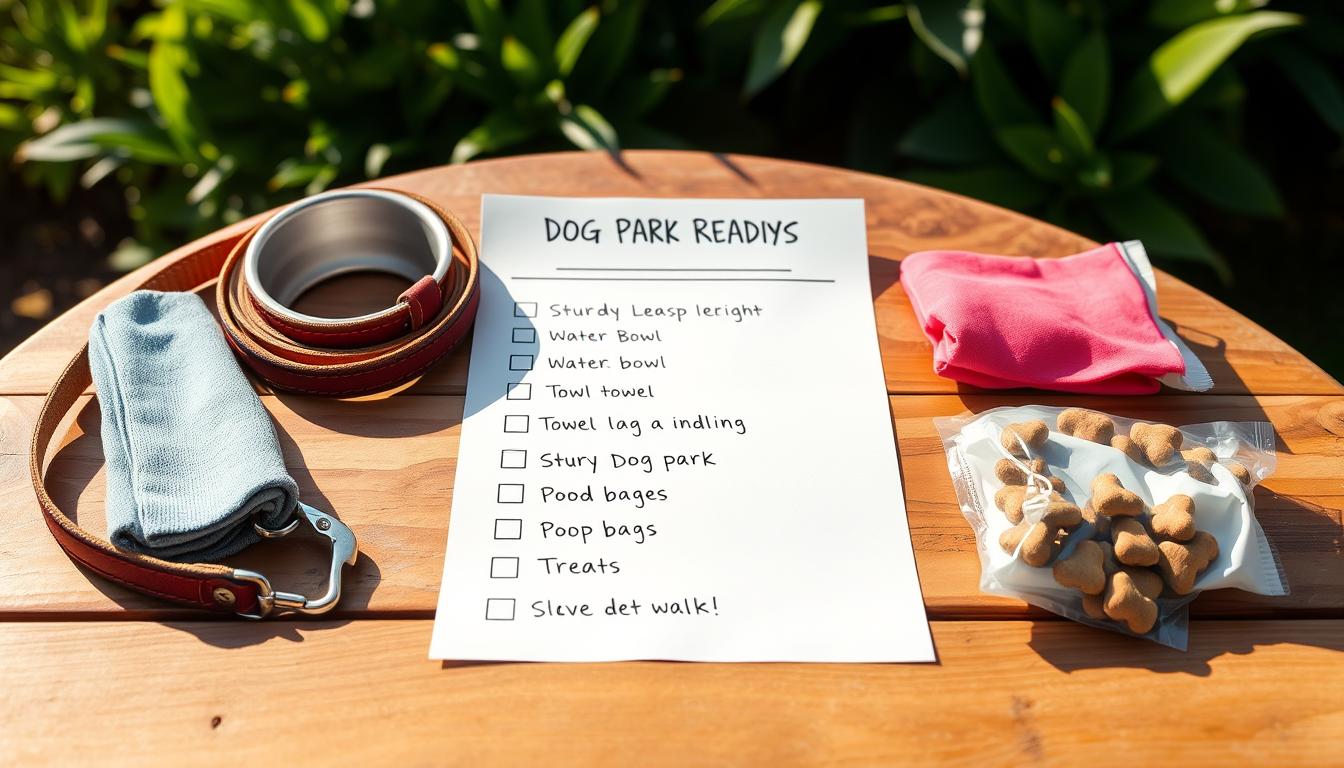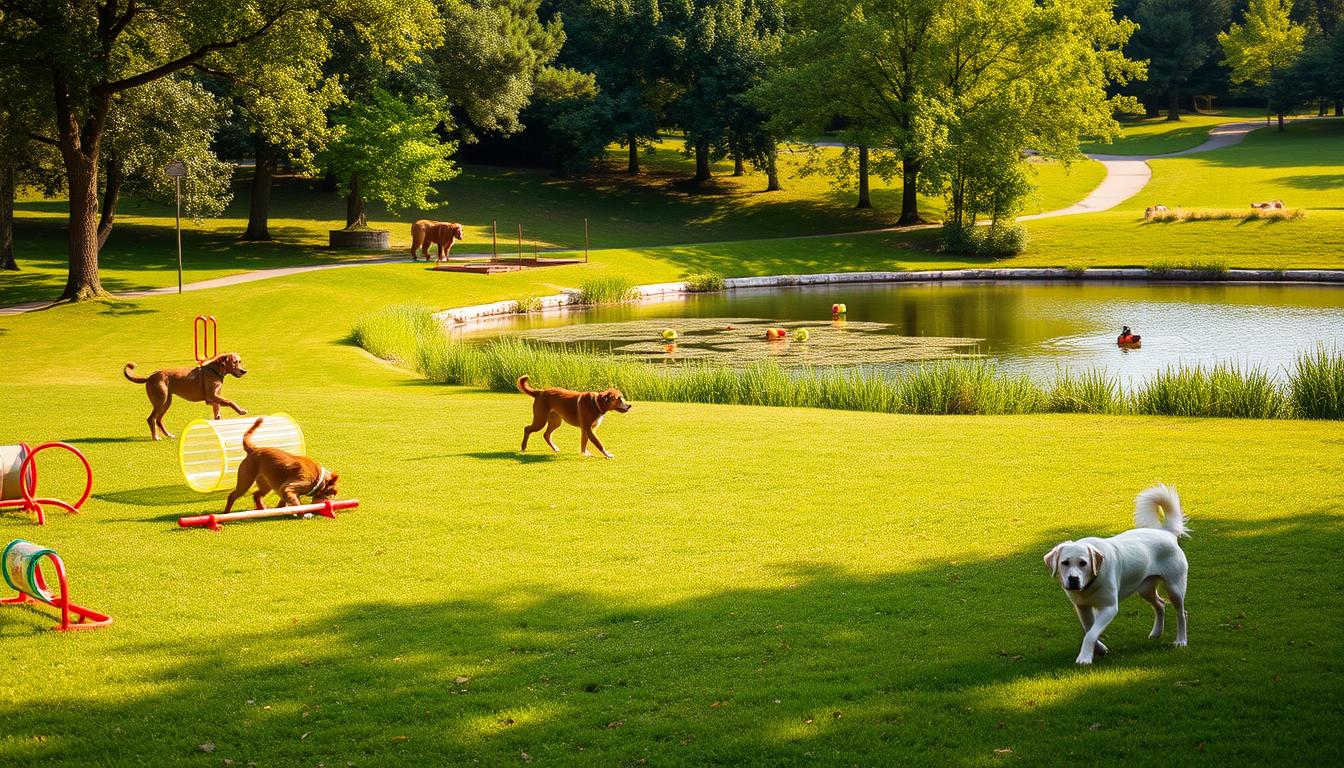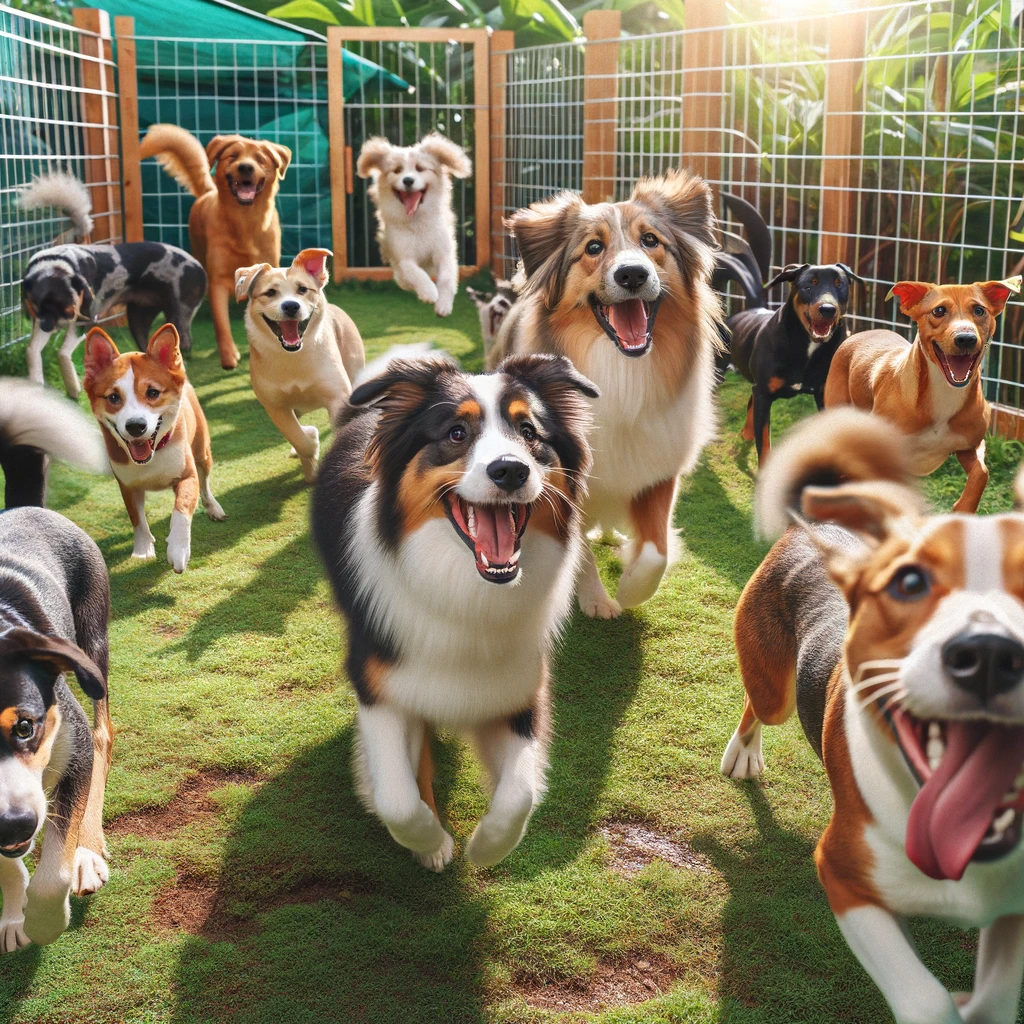Thinking about taking your dog to the off-leash dog park? Wondering if they’re ready for it? It’s important to check if they’re ready for dog park adventures.
PreventativeVet.com says a dog should be friendly, healthy, and socialized before going to a dog park. This makes us ask: how can you tell if your dog is ready for off-leash fun?
Knowing if your dog fits well in dog park settings is key. It makes sure both you and your pet have a good time.
Key Takeaways
- Check if your dog is friendly before taking them to the dog park.
- Make sure your dog is healthy and has all their shots.
- Socialization is important for a good dog park experience.
- Look at how your dog acts around other dogs and people.
- Think about your dog’s age, breed, and how they feel around others.
Understanding Dog Parks: Benefits and Possible Risks
Before taking your dog to an off-leash park, it’s key to know what to expect. Dog parks are great for canine socialization. They offer a place for dogs to play and exercise freely.
What to Expect at a Typical Dog Park
A typical dog park is a fenced area for dogs to run off-leash. They come in different sizes and have amenities. There are usually separate areas for big and small dogs.
When you go to a dog park, you’ll see dogs of all breeds and sizes. It’s important to watch the park and other dogs before letting your pet in. This ensures it’s safe for them.
Benefits of Dog Park Socialization
Dog parks are great for canine socialization. Socialization helps dogs feel confident and calm around other dogs and people. Regular visits can improve your dog’s behavior and reduce anxiety or aggression.
Also, dog parks are a chance to meet other dog owners. This can lead to new friendships and a sense of community.
Common Concerns and Risks
While dog parks have many dog park benefits, there are risks. One big concern is dog fights. Dogs may not always get along, leading to conflicts. There’s also a risk of disease transmission among dogs.
To avoid these risks, make sure your dog is up-to-date on vaccinations. Also, watch their behavior closely at the park. Knowing these dog park risks helps you take steps for a safe and fun time for you and your dog.
Essential Skills Your Dog Needs Before Visiting an Off-Leash Park
Before heading to the dog park, make sure your dog has the right skills. Leighann Hurley, CPDT-KA, says your dog should come back to you with just one command, even if they’re distracted. This shows how key reliable recall training is.
Reliable Recall Training Techniques
Recall training is key for off-leash training. It teaches your dog to come back fast when called, even with distractions. Start in a quiet place with few distractions.
First, practice in a controlled area. Use a leash or a fenced space. Then, increase the distance while calling your dog. Give treats and praise when they come back. As they get better, add distractions and practice in different places.
Basic Obedience Commands for Dog Park Safety
Your dog also needs to know basic obedience commands for safety. Commands like “sit,” “stay,” and “leave it” help manage their behavior. This is important in busy dog parks.
Practice these commands often. Use positive rewards to encourage good behavior. This way, you can step in if needed and keep your dog safe.
Leash Manners and Greeting Etiquette
Before going off-leash, teach your dog good leash manners and how to greet others. They should walk calmly on a leash and not jump up or bark too much when meeting other dogs or people.
“A dog that is well-behaved on a leash is more likely to be well-behaved off-leash,” says dog training experts. Practicing good leash etiquette helps in maintaining a safe and enjoyable environment for both dogs and their owners.
By focusing on these essential skills, you’ll be ready for a fun and safe trip to the off-leash dog park.
Assessing Your Dog’s Temperament for Dog Park Readiness
Before taking your dog to a dog park, it’s key to check their temperament. Dog parks are great for socializing dogs, but not all dogs are ready. It’s important to see how your dog acts around other dogs to keep them safe.
Signs Your Dog May Enjoy the Dog Park
If your dog is friendly and loves being around other dogs, they might like dog parks. Signs of a dog ready for the dog park include wanting to play, staying calm with other dogs, and listening to commands.
Dogs that want to play with others and do so without being aggressive will likely enjoy dog parks. Watching how your dog acts on walks or at dog daycare can tell you a lot about their dog park readiness.
Red Flags That Indicate Your Dog Isn’t Ready
Some dogs aren’t ready for dog parks because of their behavior. Red flags include being aggressive, scared, or too bossy. If your dog shows these signs, talk to a dog trainer or behaviorist.
Dogs that are scared or anxious around other dogs shouldn’t go to dog parks. Try safer ways to socialize them instead.
Special Considerations for Puppies and Senior Dogs
Puppies and senior dogs have special needs at dog parks. Puppies need to be fully vaccinated and their energy levels should match the other dogs. This helps avoid any problems.
Senior dogs need to be checked if they can handle dog park activities. Look at their health and how well they can move before taking them. It’s important to watch how they behave and adjust as needed.
Dog Park Readiness: Is Your Dog Ready for the Off-Leash Park?
Getting your dog ready for the dog park is key. You need to check their skills, health, and how well they get along with others. This ensures they stay safe and have fun.

A Comprehensives Readiness Checklist
First, check if your dog knows basic commands. They should listen well, even when there’s a lot going on. Knowing commands helps keep them safe and in control.
Reliable recall and basic obedience are must-haves. Your dog should also get along well with other dogs and people. This is important for a good time at the dog park.
Health Requirements and Vaccinations
Make sure your dog’s vaccinations are current before going to the dog park. This keeps them safe and helps keep the whole park healthy. Talk to your vet about what shots your dog needs.
Think about your dog’s health too. Some dogs might not be good for the dog park because of health issues. Your vet can tell you if it’s safe for your dog.
Age-Appropriate Socialization Strategies
Socializing your dog is very important, and it depends on their age. Puppies should wait until they’re fully vaccinated to go to dog parks. Senior dogs need socialization that fits their energy and health level.
For any age, use positive training methods. This helps your dog behave well and enjoy the dog park without stress.
Preparing for Your First Dog Park Visit
Planning is key for a great first dog park visit. Know what to expect and prepare for a fun, safe time with your dog.
Essential Gear to Bring
Make sure you have the right gear before you go. Bring a sturdy leash, a comfy harness, and lots of poop bags. Don’t forget water and a portable bowl for hydration. Healthy treats are great for rewarding good behavior.
Timing Your Visit for Success
When you visit can make a big difference. Try to go when it’s not too busy. A quieter time lets your dog adjust better to the new place.
Pre-Visit Exercise Strategies
Exercising your dog before the park can make things better. Take them for a brisk walk or play fetch. This pre-visit exercise helps them relax and enjoy socializing.
Introducing Your Dog to the Park Environment
When you get to the dog park, take a minute to observe the surroundings. Let your dog sniff and explore while on a leash. Then, let them off-leash and watch their behavior closely. Be ready to step in if they seem stressed or uncomfortable.
Dog Park Etiquette and Rules
Knowing the rules of dog parks is key for a good time with your dog. These parks are for off-leash fun but need owners to be responsible.
Common Dog Park Rules to Follow
Dog parks have rules for everyone’s safety and fun. You’ll need to show your dog’s up-to-date shots, spay/neuter papers, and ID. They also set limits on how many dogs you can bring and how to handle aggressive dogs.
Learn the dog park’s rules before you go. This helps you avoid problems and keep an eye on your dog.
Owner Responsibilities and Vigilance
As a dog owner, watch your dog closely at the park. Make sure they’re not bothering others and step in if needed. Being ready for anything is important.
“The second source stresses the importance of being attentive and prepared to mitigate negative situations at the dog park.”
It’s your job to clean up after your dog and respect others. By watching your dog and being responsible, you help keep the park safe and friendly for everyone.
How to Politely Handle Difficult Situations
Even with the best owners, problems can happen at dog parks. Whether it’s a scary dog or a scared one, knowing how to act is key.
If you see an aggressive dog, calmly call your dog and leave. Try to avoid fights and ask for help if you need it.
By knowing the rules, being a responsible owner, and handling tough situations well, you can make sure everyone has a great time at the dog park.
Recognizing and Responding to Dog Park Problems
Being ready for problems at the dog park is important. Enjoying the freedom off-leash, stay alert. Watch for signs of stress or discomfort in your dog and others.
Reading Canine Body Language
Knowing dog body language at dog park is key. Dogs mainly talk through body language. A relaxed dog has a loose, open posture. A tense dog stiffens and may show raised hackles.
Watch your dog’s actions closely. Look for dog park aggression signs like growling or stiffening. If you see these, act fast to stop things from getting worse.
Signs of Stress or Discomfort
Dogs show stress or discomfort in many ways. They might yawn, lick their lips, or avoid eye contact. If your dog is doing these things, it’s time for a break or to leave.
Other signs include panting, pacing, or hiding behind you. Catching these signs early helps avoid bigger problems.
When and How to Intervene in Dog Interactions
Intervening in dog interactions needs calm and assertiveness. If a dog is getting aggressive or stressed, step in calmly. Use a command or distraction to keep dogs apart.
Preventing and Breaking Up Dog Fights
Preventing dog fights is better than stopping them. Watch your dog closely and be ready to step in. If a fight happens, stay calm and use a loud noise or barrier to separate them.
Never try to break up a fight with your body. It can hurt you. Instead, create distance and get help from others or park staff.
Alternatives to Traditional Dog Parks
If your dog doesn’t like traditional dog parks, don’t worry. There are many other options. Dog parks are great for socializing, but some dogs prefer quieter places. You can find other ways to keep your dog active, social, and mentally sharp.

Structured Playgroups and Daycare
Structured playgroups and dog daycare offer a safer space for your dog. They have trained staff to watch over the dogs and keep everyone safe. This is perfect for dogs that need extra help or have special needs.
In these groups, dogs are matched by size, age, or energy level. Dog daycare centers also offer fun activities like playtime and training. This keeps your dog busy and happy.
Private Dog Park Rentals
Private dog park rentals offer a quiet, exclusive space for you and your dog. It’s great for dogs that get overwhelmed by loud dog parks. You can enjoy a dedicated area without the noise.
These parks often have cool features like agility equipment and swimming areas. They also have comfy spots for owners to relax. It’s a unique way to make your dog’s playtime special.
Creating Safe Off-Leash Experiences Elsewhere
You can also find safe places for your dog to run off-leash. Look for quiet spots in local parks or trails. These areas are less crowded and safer for your dog.
When exploring these spots, always follow local rules. Keep an eye out for dangers like wildlife or toxic plants. Be aware of other people in the park too.
Socialization Options for Dogs Not Ready for Dog Parks
If your dog isn’t ready for dog parks, there are other ways to socialize them. Puppy socialization classes or one-on-one training are great. They help your dog learn important social skills.
You can also set up playdates with other dogs or visit dog-friendly places. Pet stores and outdoor cafes are good options. Socializing your dog is an ongoing process, and there are many ways to do it.
Conclusion
Checking if your dog is ready for an off-leash park is key for a good time for everyone. Knowing the good and bad sides of dog parks helps you decide if it’s right for your dog.
To keep your dog safe at the park, look at their personality and train them well. Also, follow the park’s rules and etiquette. This way, you help make the park a great place for dogs to play and meet others.
Whether you’ve been to dog parks before or it’s your first time, getting your dog ready is important. Focus on safety and what your dog needs. This way, you ensure a fun and safe outing for your furry friend.
FAQ
What are the benefits of taking my dog to a dog park?
Dog parks are safe places for your dog to play and meet others. They help your dog learn to get along with other dogs. This is good for their happiness and behavior.
How do I know if my dog is ready for a dog park?
Check if your dog is friendly and listens to you. They should know basic commands and not be too aggressive. If they’re well-behaved, they might be ready.
What are the essential skills my dog needs before visiting an off-leash park?
Your dog needs to come when called and know basic commands. They should also be polite on a leash. This helps them play safely with others.
What health requirements and vaccinations are necessary for dog park visits?
Make sure your dog’s shots are current, including rabies and distemper. Talk to your vet about what your dog needs.
How can I introduce my dog to the dog park environment?
Go to the park when it’s not too busy. Start with your dog on a leash. Then, let them play off-leash while watching them closely.
What are some common dog park rules to follow?
Rules often include picking up after your dog and not bringing aggressive dogs. Know the specific rules at your park.
How can I recognize signs of stress or discomfort in my dog at the dog park?
Look for signs like a tucked tail or avoiding other dogs. If you see these, take your dog away to calm them down.
What alternatives are available if my dog isn’t suited for traditional dog parks?
Try playgroups or renting a private dog park. You can also create safe areas for your dog to play. These options meet your dog’s needs.
How can I prevent dog fights at the dog park?
Keep an eye on your dog and watch for aggressive signs. Use a short leash when entering or leaving. Avoid bringing treats that might cause fights.
What should I do if a dog fight breaks out at the dog park?
Stay calm and use a barrier or loud noise to separate the dogs. Don’t try to physically stop the fight, as it could hurt you or the dogs.





